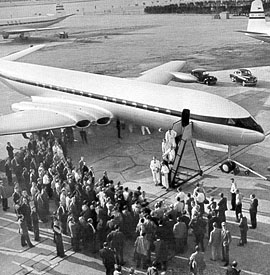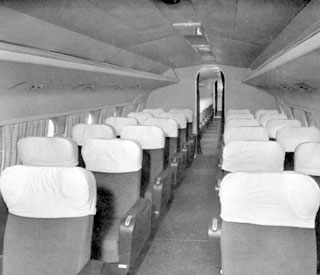

Comet 3
A single Comet 3 prototype was built: G-ANLO. Its construction straddled the crash investigation; it was too late to incorporate the major structural changes necessary after the inquiry, but it was given oval windows and the exhausts were canted away from the fuselage.
Aerodynamics and systems were identical to the future Series 4, and a lot of development work was done on G-ANLO while the Comet 4 was on the drawing board. A certificate of airworthiness was issued for unpressurised flight, and testing began on 19 July 1954. In fact the Comet 3 achieved 80% of certification for the Comet 4. Because of that, the total delay to the programme was little longer than a year.
This new aircraft was so different to the Series 1/2 that there was a suggestion in government that the name should be changed. This was rejected by both de Havilland and BOAC, who were keen to restore the Comet’s reputation, not to bury it.
G-ANLO remained at de Havilland for conversion to “B” specification, with shorter wings and without its distinctive pinion tanks. After that, it passed to the Ministry of Supply under a new registration, XP915. It became one of four aircraft types used at the Blind Landing Experimental Unit (BLEU) at RAE Bedford. In 1964, it was used to evaluate the Comet as a potential replacement for Avro Shackletons, used by RAF Coastal Command. For this use, the Comet's low-speed handling was a distinct boon, because it could dash quickly to the target and then to fly slowly for long periods, or “loiter” over the target.
